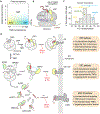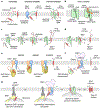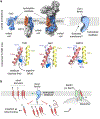The mechanisms of integral membrane protein biogenesis
- PMID: 34556847
- PMCID: PMC12108547
- DOI: 10.1038/s41580-021-00413-2
The mechanisms of integral membrane protein biogenesis
Abstract
Roughly one quarter of all genes code for integral membrane proteins that are inserted into the plasma membrane of prokaryotes or the endoplasmic reticulum membrane of eukaryotes. Multiple pathways are used for the targeting and insertion of membrane proteins on the basis of their topological and biophysical characteristics. Multipass membrane proteins span the membrane multiple times and face the additional challenges of intramembrane folding. In many cases, integral membrane proteins require assembly with other proteins to form multi-subunit membrane protein complexes. Recent biochemical and structural analyses have provided considerable clarity regarding the molecular basis of membrane protein targeting and insertion, with tantalizing new insights into the poorly understood processes of multipass membrane protein biogenesis and multi-subunit protein complex assembly.
© 2021. Springer Nature Limited.
Figures





References
Publication types
MeSH terms
Substances
Grants and funding
LinkOut - more resources
Full Text Sources

